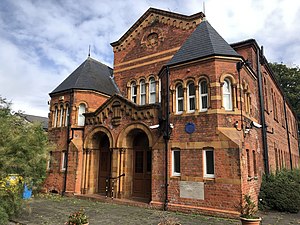Kingston upon Hull, on England's East Coast was, by 1750, a major point of entry into Britain for traders and migrants,[1][2][3] second only to London for links to the continent.[4] Around then, a few Jews from German and Dutch cities lodged and settled in Hull.[5][6][7] Selling jewelry and dealing goods in the thriving port and market town, they maintained contacts with Europe, London, and many other – particularly Northern – towns. The small community produced its own institutions and leaders, which were tested by anti-Jewish sentiment, and later by an influx of East-European refugees.[5][8]
Communal efforts to support the arrival of Jews – mostly bound for America – encouraged some to stay, who then thrived particularly well in retail trades, and grew to be a community of over 2,500.[5][9] Although probably never more than 1% of the area population, by the end of the twentieth century the Jews of Hull made an impact on the life of the city, and some became known in the broader world.[10] Among the sons and daughters of the Jews of Hull (as well as many Lord Mayors and Sheriffs of Hull) were three Fellows of the Royal Society,[11] the founder of the world's largest furniture maker,[12] numerous doctors and lawyers, as well as actress Dame Maureen Lipman.[13] See List of Jews from Kingston-upon-Hull.

- ^ Sheahan, James Joseph (1864). General and concise history and description of the town and port of Kingston-upon-Hull. Online at: University of California Libraries. London: Simpkin, Marshall & Co.
- ^ Evans, Nicholas (2017). "The making of a mosaic: Migration and the port-city of Kingston upon Hull". In Starkey DJ (ed.). Hull: Culture, History, Place. Liverpool: Liverpool University Press. pp. 144–77. ISBN 978-1-78138-420-6.
- ^ Finestein, Israel (2002). Scenes and personalities in Anglo-Jewry, 1800–2000. London: Vallentine Mitchell. p. 112. ISBN 0-85303-443-5. OCLC 50123510.
- ^ Finestein, Israel. "Hull. In JCR-UK: Hull – Provincial Jewry in Victorian Britain (Papers by Aubrey Newman)". jewishgen.org. Retrieved 10 December 2021.
- ^ a b c Finestein, Israel (1996). "The Jews in Hull, between 1766 and 1880". Jewish Historical Studies. 35: 33–91. ISSN 0962-9696. JSTOR 29779979.
- ^ Cite error: The named reference
:19was invoked but never defined (see the help page). - ^ Margoliouth, Moses (1851). The History of the Jews in Great Britain, Volume 3. London: Richard Bentley. p. 134.
- ^ Cite error: The named reference
:60was invoked but never defined (see the help page). - ^ Cite error: The named reference
:20was invoked but never defined (see the help page). - ^ Lang, Colin (2017). Divided we stand: a journey with Judge Israel Finestein QC (English ed.). London: Vallentine Mitchell. p. 223. ISBN 978-1-910383-50-6. OCLC 995382563.
- ^ Salaman, Redcliffe N. (1948). "The Jewish Fellows of the Royal Society: Paper read before the Jewish Historical Society of England, 15th December, 1947". Miscellanies (Jewish Historical Society of England). 5: 146–175. ISSN 2047-234X. JSTOR 29777119.
- ^ Bruce Castle Museum, Haringey. "Investigating the past. The Harris Lebus factory" (PDF). Wayback Machine. Archived from the original (PDF) on 11 February 2014. Retrieved 17 June 2022.
- ^ Green, Alex (9 October 2020). "Hull born actress Maureen Lipman made a dame by the Queen". HullLive. Retrieved 2 May 2021.
- ^ Historic England. "Former Western Synagogue, Linden House (1283079)". National Heritage List for England. Retrieved 26 March 2021.